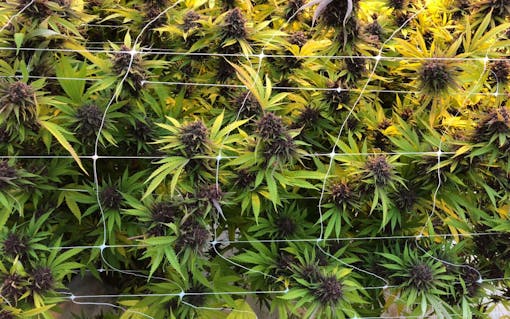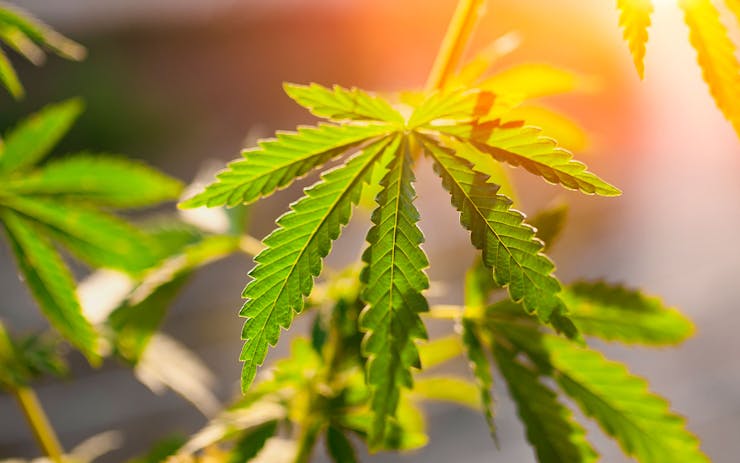We’re in the midst of the outdoor harvest season for cannabis. What does a massive harvest of cannabis look like, you might wonder? I did too, so I hit the streets for a little education. In my mission to learn more about sun-grown cannabis in Washington, I visited Canna Organix in Seqium, CannaSol in Okanagan, and Walden Cannabis in Brewster.
What began as a routine series of farm tours quickly turned into one of the biggest learning experiences I’ve had since hopping into the industry. Here are some of the most important lessons I took away.
Get more tips and advice on the benefits of growing marijuana outdoors in Leafly’s Growing Guide.
1. There is no “best” way to grow cannabis.

Pictures taken at Canna Organix (Dante Jordan/Leafly)
There’s this whole beef within the community about which method grows the best cannabis: indoor, greenhouse, or full-term outdoor. But I learned that there truly is no answer to this question—each method has its advantages and disadvantages:
- With indoor, you can grow a wider variety of strains year-round, however this method consumes more energy, electricity, and resources, leaving a larger carbon footprint.
- With greenhouse, you’re able to use the sun to sustainably grow the plant in its most natural state, as well as using light deprivation (intentionally blocking out the sun with tarps to induce flowering), which results in the most natural terpene profiles. However you must alter your greenhouses every single day according to the temperature outside.
- With full-term outdoor, you’re able to grow cannabis with the least amount of overhead, in the most sustainable way. However, you’re subject to the outdoor elements that put your plants at risk.
2. SUH-STANE-UH-BILL-IT-EE.
Sustainability is one of the major buzzwords floating around my eardrums lately. The true definition is up to interpretation, but essentially, sustainability is all about growing cannabis in its most natural state (by using the sun and reusing soil), and using less of the earth’s resources to create the cleanest and greenest version of cannabis.
All the growers I spoke with believe that the market will eventually begin calling for products made from more sustainably-grown cannabis. Only time will tell, since we’re still waiting to see consumer demand for it.
3. The PNW is ideal for sustainably-grown cannabis

Pictures taken at Canna Organix (Dante Jordan/Leafly)
During my time with the incredible folks over at Canna Organix, I learned that the ideal temperature for growing cannabis is between 73-80°F. That means the Pacific Northwest, which generally hovers around that temperature range from July through September, is the perfect place to throw some seeds into the soil and let them do what they do.
There’s this stigma that “outdoor weed is shitty” in the cannabis industry, but with Washington’s mild temperatures and low humidity, you can really produce some great sun-grown cannabis ‘round these parts.
Shop highly rated dispensaries near you
Showing you dispensaries near4. Pesticides are everywhere.
“Pesticides” is the biggest buzzword in cannabis right now. Everyone’s rushing to say they grow the best pesticide-free cannabis out there, but every time I ask a grower about pesticide use, the answer is never a flat-out “No.” It’s always “Yeah, well, but…”
When growers say “pesticide-free,” they most likely mean that pesticides were implemented during the plant’s vegetative state, not flowering. Every single grower that I’ve question about this always passionately screams that anyone who says they are completely pesticide-free is lying. Until Washington requires more detailed testing and packaging, it’s hard to ever know the facts.
5. Federalization legalization could be bad for Washington’s sun-growers.

Pictures taken at Canna Organix (Dante Jordan/Leafly)
We all cry for federal legalization of our beloved plant, but is it good for everyone? For certain cannabis growers, the answer is no. With the indoor growers controlling the market and there being such a low demand for sustainably-grown cannabis, the moment this thing goes federal is the moment that companies are able to receive funding from out-of-state properties.
When that happens, all of the big-name growers, mostly indoor, will receive a huge influx of funding from outside entities, leaving most sun-grown cannabis farmers with absolutely nothing.
6. The reason there are $3 pre-rolls and $50 ounces.
I’m all about saving green on green, but there have definitely been times when I’ve seen a price so low—like the $50 ounces that I saw at Ruckus—and thought, “WHAT?! HOW?!” After a series of tours, I now know the answer.
On one hand, there are brands that throw their trim and boof weed into pre-rolls then sell them for who-cares-it-was-trash-anyway prices. But it’s extremely difficult to grow quality full-term outdoor cannabis (which is why most companies only use it to process concentrates), so the growers that do sell it as flower tend to do so at astronomically cheaper prices. With the market calling for the highest quality of products, this is why you only see these products at certain dispensaries geared toward value-minded consumers.
7. Washington retailers mark up prices by 300%.

Pictures taken at Canna Organix (Dante Jordan/Leafly)
Ever wonder why cannabis is so expensive? Well, allegedly, cannabis retailers mark up their prices by about 300%. For my mathematically-challenged folks, that means if a dispensary sells you a gram for $10, they probably bought it for $3 or $4 dollars.
This made sense when the market demanded high-quality products that were rarely available, but now that there’s a surplus of great cannabis, it’s a little whack in terms of the dispensary relationships with both customers and growers. None of that bottomline net income is being kicked back to the growers, which means, due to a surplus of supply, they’re being forced to sell products for pennies, yet the buyers of those products are making whole-ass quarters.
Yes, this is how business works. No, that doesn’t mean it’s right.Craving Sun-Grown Cannabis Options?







